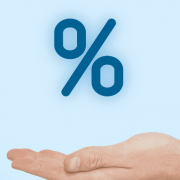The Impact of Higher Mortgage Rates on Industrial Property Values
Pricing for industrial properties in San Diego started to take off in 2011 after bouncing along the bottom for close to three years following the onset of the Great Recession. It took time for local business owners to get back on their feet after a grueling and protracted economic slowdown. The performance of the industrial market since the recovery began has been nothing short of incredible. It was a run-up in pricing that even the most experienced real estate professionals couldn’t make sense of, even those of us who have been around for three or more real estate upcycles. In simplest terms, it was the perfect storm created by historically low interest mortgage rates combined with product scarcity that best explains it.
Let’s take a quick look at why mortgage rates fell:
In its aggressive attempt to revive the US economy from the Great Recession, Fed Chairman Ben Bernanke and his Federal Open Market Committee pulled out all the monetary stops. First, it lowered its benchmark Fed Funds Rate to 0% to reduce borrowing costs for just about everything. America went on a borrowing binge, but the hoped-for boost in GDP and job growth just didn’t materialize. So, the Fed started printing money in its magic computer and bought US Treasuries held in reserve by the banks. The supply of cash to loan increased, effectively driving the cost of capital to borrowers even lower. The Fed even bought mortgage-backed bonds from Fannie Mae and Freddie Mac to make sure there was a plentiful supply of cash to loan to homebuyers at low rates. Mortgage rates for industrial properties fell to historical lows, as well, which stimulated demand from owner/users as well as investors. Prices started moving higher as buyers competed against one another to be the winning bidder.
That all didn’t work as hoped either, but the Fed kept its foot on the monetary gas pedal for several years anyway, ballooning its own balance sheet to over $4.5 trillion before finally backing away from the policy in 2015. They began to shrink the balance sheet and slowly raise rates to a more neutral monetary stance, but they didn’t go far enough to send mortgage rates appreciably higher. Prices for industrial properties kept moving up and vacancy fell to new lows as demand continued unabated. With San Diego lacking the land for full-scale development of industrial property, the scarcity of quality properties drove prices even higher.
Then the pandemic hit and they did the same thing all over again, returning the Fed Funds Rate to 0% and swelling the balance sheet to over $9 trillion this time around. Meanwhile, the federal government issued trillions of dollars in new debt to distribute cash to businesses and citizens to mitigate the impact of the massive economic shutdowns occasioned by the pandemic. Guess who bought over half of that debt issued by the Treasury Department to pay for all the help? You guessed it; the Fed. If that sounds a little shaky to you, you’re not alone.
Before we knew it, the money supply had increased by over 40% and pandemic-induced supply chain problems just couldn’t keep pace with all that new cash burning a hole in the American consumer’s collective pocket. Not surprisingly, inflation higher than we’ve experienced in over 40 years, was the result. The Fed reversed course, shut down the bond-buying and raised the Fed Funds Rate seven times last year to take it from 0% to approximately 4.5%. Fingers are now crossed throughout the country, hoping that the Fed’s aggressive tightening came soon enough to stop inflation before it causes long-term damage to the economy.
So, as you might expect, if lowering the Fed Funds Rate sent mortgage rates down, then raising the same rate would make them go up. That is indeed the case. Just in the past year, the cost to service mortgage interest has more than doubled. The interest component of the payment on a $2 million industrial building loan for 25 years in year 1 has risen from approximately $5,000 per month to just under $11,000 per month. To say the least, that would discourage a buyer from paying a record price for a building.
Put another way, to keep the payment the same today attached to that $2 million loan that came with an interest rate of 3% a year ago, the borrower would have to reduce the mortgage to just $1,404,000 assuming a current rate of 6.5%. If the down payment was 10% of the purchase price, the buyer could pay only $1,560,000 for the same building with the 6.5% rate, versus $2,222,000 with a mortgage rate of 3%.
The math is inescapable and so is the logic for why property values skyrocketed when rates were ridiculously low and why prices will have to come down as rates move up. We just don’t know at this point where the rate hikes will end and how much damage the inflation battle does to the economy. The good news is that while money is no longer cheap, supply is still at an historic low. We won’t have to absorb the glut of supply we have in past down-cycles because development activity has been almost non-existent this time around. That will allow demand to fall back into balance with supply quicker and, hopefully, without a wild swing in prices before equilibrium returns.









